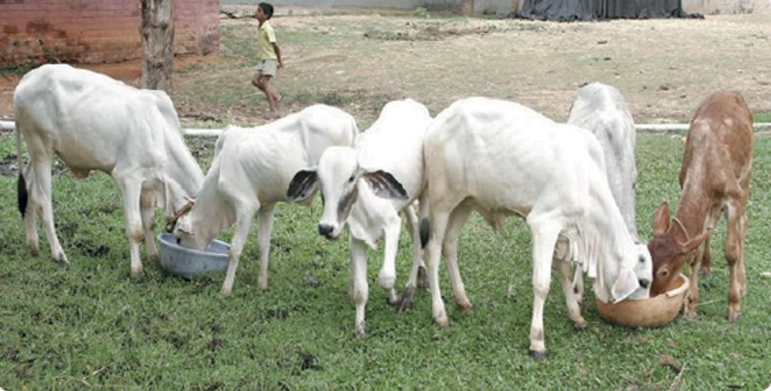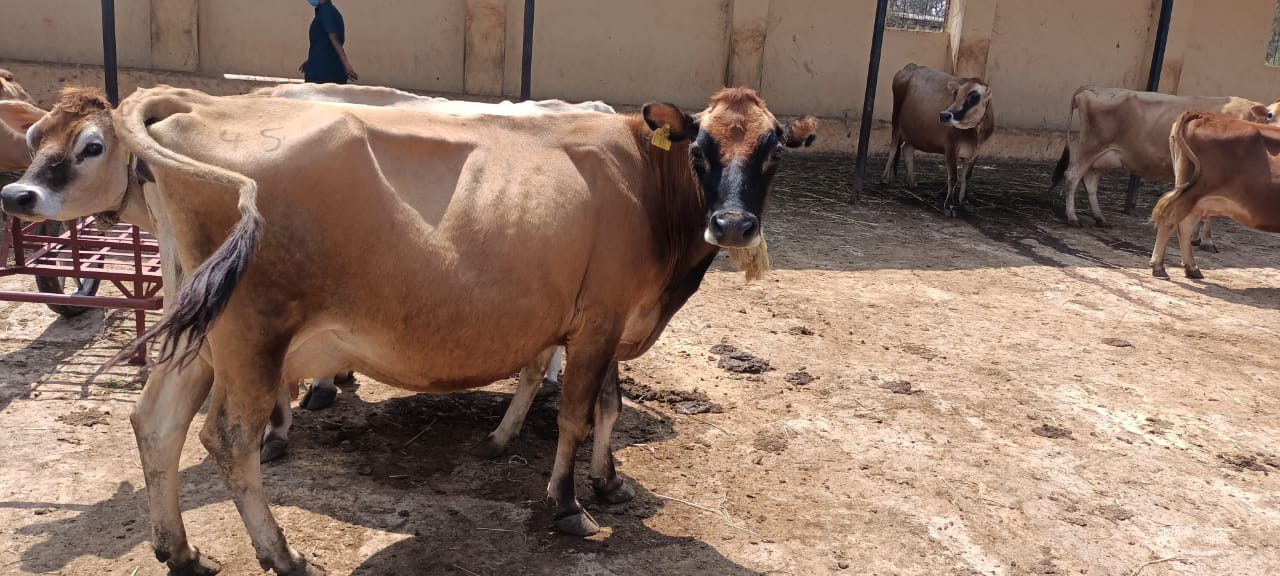Calf Management
- Immediately after birth, though the cow licks the calf clean, the extra mucous or phlegm from the calf’s nose and mouth can be removed to stimulate breathing and circulation.
- If cold, keep the calf warm by rubbing and drying the calf with a dry cloth or gunny bag.
- Tie the calf’s umbilical cord about 3-5 cm away from its body. Make an incision 1 cm below the ligature and apply tincture of iodine to avoid infection.
- The calf should be fed the cow’s colostrum (the milk produced 4-5 days after calving) within 30 minutes to two hours of birth. If the calf isn’t getting enough colostrum and later milk, pooled colostrum or milk from other cows can be used.
- Artificial colostrum can also be procured from markets. However, artificial colostrum can also be prepared using an egg, half liter of fresh warm water, half liter of whole milk, a teaspoon of castor oil and similar amount of cod liver oil.
- Veterinarian must be contacted to carry out disbudding 10-15 days after birth.
- Start the calf on starter/good quality grain when two weeks old; fresh water should be given from the age of 2-3 weeks. Start the calf on starter/good quality grain when two weeks old; fresh water should be given from the age of 2-3 weeks.
- Calves should be fed whole milk/milk replacer at least up to 2 months.
- House the calves in individual calf pens for 3 months, and then in groups.
- After 6 months, male and female calves should be housed separately.
- Male calves should be castrated at 8-9 weeks.
- Proper feeding and regular deworming will achieve a growth rate of 10-15 kg/month.
- Strictly follow vaccination and deworming schedules.

Care and Management of Milch Animals
- Milch animals should have a proper and organized feeding regimen to enable maximum lactation.
- Extra concentrate at the rate of 1 kg/2-2.5 liters of milk should be provided.
- Salt and mineral supplements should be given to maintain lactation.
- Provide water as often as necessary.
- Maintain regularity in milking. Use the full hand method to milk.
- Train cows to lactate without the calf suckling. This will help to wean the calves early.
- In buffaloes, grooming, washing and wallowing must be practiced as required.
- Maintain a 60-90 days dry period between calving. An insufficient dry period will lead to reduced lactation.
Care and Management of Heifer
Better Care and Management of heifer will give high quality replacement stock to the dairy farm. The following care and Management practices are recommended for a heifer.
- Feed the heifer sufficiently to produce normal growth. During the early stage relatively more protein than energy is needed. Most heifers grow well if excellent hay is given as much they can eat. The amount of growth depends upon the quality of forage fed.
- The heifers should be provided with a dry shelter free from drafts. A loose housing system with a shelter open to one side is sufficient.
- The size rather than the age of a dairy heifer at breeding time is important. Breeding under sized animals is never profitable. They may be stunted or slow to reach maximum size. Small heifers are more likely to have difficulty in calving.
Care and Management of Pregnant Animals
- Do not allow them to mix with other animals that have aborted or that are suffering from or carriers of diseases like brucellosis.
- Allow moderate exercise, which helps in calving normally.
- Do not tire them by making long distances especially on uneven surfaces.
- Do not allow them to fight with other animals and take care that they are not chased by dogs and other animals.
- Avoid slippery conditions, which causes the animal to fall receiving fractures, dislocation etc.
- Pregnant animals should be watched carefully, particularly during the last stages of pregnancy to avoid abortion due to fights or other physical trauma.
- During the last three months of pregnancy when foetal growth is very rapid, a special allowance of about 1-2 kg of concentrate should be included.
- Feeding trace mineralized salt plus recommended amounts of calcium and phosphorus is essential.
- Balanced and laxative rations should be fed to maintain the normal tone of the reproductive tract.
- Isolate the pregnant animal 10-15 days before calving is due. Keep it in a clean, well bedded, dry and disinfected maternity pen.
- Watch the animal every 2-3 hours as calving time approaches.
- Swelling of external genetalia and udder are symptoms of ensuring delivery.
- Most animals will deliver without any help. In case of any difficulty, provide veterinary help.
- Do not tire the animal by making it move over long distances, especially on uneven surfaces.
- Ensure it is not fighting with other animals or chased by dogs and other animals.
- Calving problems must be attended by a veterinarian.
- Placenta is normally expelled 2-6 hours after calving. If this doesn’t happen within 12 hours, a veterinarian must be called to attend the animal. Take care of the animal before calving from milk fever.
- After calving, the animal must be encouraged to move to the manger for feeding, especially on the day of calving and the first two days after calving.
- Provide clean drinking water and protection from thermal stress.
- Give calcium supplement. Sometimes the udder will be swollen just before calving. Remove the milk partially. Take care, of the animal, if at all any abortion. Provide always free access to drinking water.
- If accurate breeding records are available, calculate the expected date of calving. Separate it one or 2 weeks before and shift to individual parturition pens.

Gestation Period
| Sl. No | Animal | Gestation Period |
|---|---|---|
| 1 | Cattle | 283 days (9 months +9 days) |
| 2 | Buffalo | 310 ys (10 months +10 days) |
Scientific Management Practices
Disbudding
- Hot-iron disbudding is commonly performed and is reliable, but is considered to be quite painful. Electrical and butane hot-iron disbudding devices are available. Excessive heat applied during hot-iron disbudding can damage underlying bone. Disbudding via cautery may create less distress than physical dehorning using a scoop because nociceptors are destroyed by heat and pain perception is consequently reduced.
- Caustic materials (e.g., sodium hydroxide, calcium hydroxide) applied to the horn bud can damage surrounding skin and/or the eyes if runoff occurs; as long as the active chemical is in contact with tissue, damage continues. Injection of calcium chloride under the horn bud results in necrosis of the horn bud, but its administration without prior sedation and/or local anesthesia is not recommended due to the level of discomfort induced by the procedure.
- Cryosurgical techniques are less reliable than hot-iron disbudding, require additional procedural time, and induce behavioral indicators of pain and distress.
Disbudding involves destroying the horn-producing cells (corium) of the horn bud. Horn buds are removed without opening the frontal sinus. Chemical and hot-iron disbudding methods destroy the horn-producing cells, whereas physical methods of disbudding excise them. Several methods for disbudding cattle exist, but each method has its advantages and disadvantages.
Horn buds can be physically removed, using knives, shears, or dehorning spoons, cups, or tubes. To remove the corium and prevent horn regrowth, a complete ring of hair surrounding the horn bud should also be removed.
Dehorning
Dehorning is removal of the horns after they have formed from the horn bud. Physical methods of dehorning (gouge dehorning) include the use of embryotomy wire, guillotine shears, or dehorning knives, saws, spoons, cups, or tubes. The Barnes-type scoop dehorner is commonly used for physical dehorning. The presence of the corneal diverticulum of the frontal sinus causes surgical dehorning of adult cattle to be more invasive. Dehorning of adult cattle is associated with increased risks of sinusitis, bleeding, prolonged wound healing, and infection.
Castration
Age Determination
Age determination in cattle
- Under two years old (No permanent teeth)
- Two years three months (2 permanent teeth)
- Three years old (4 permanent teeth)
- Three years six months (6 permanent teeth)
- Four years (8 permanent teeth)
- Old animal, over four years old
Age determination in Buffalo
- Under three years old (no permanent teeth)
- Two years six months (2 permanent teeth)
- Three years six months (4 permanent teeth)
- Four years six months (6 permanent teeth)
- Five to six years (8 permanent teeth)

